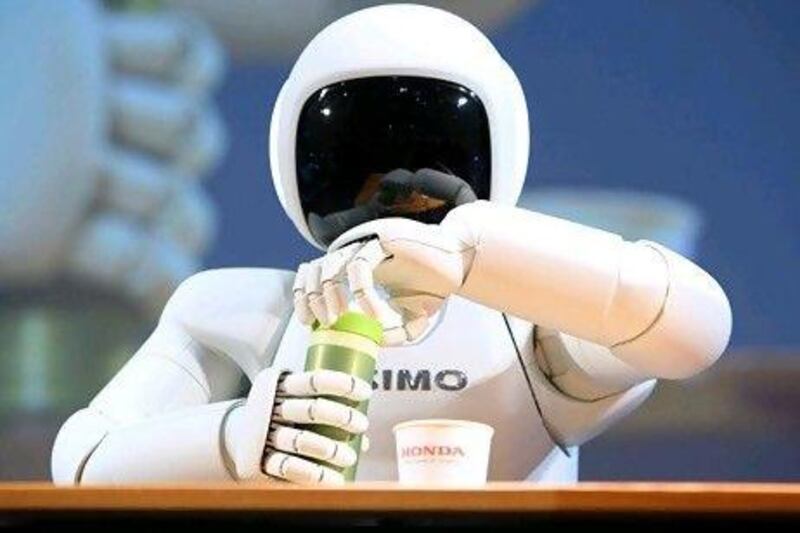California's Silicon Valley is in the throes of giving birth to its next world-changing technology - robotics.
Start-up companies are scrambling to develop humanoid-stye robots to cater for a growing demand from both businesses and consumers.
Silicon Valley Robotics, which represents 40 organisations, reports a boom in robotics start-ups in San Francisco in addition to more established companies elsewhere in the area concentrating on industrial robotics.
The start-up robot firm Momentum Machines is one. Funded by San Francisco's Lemnos Labs, it has developed a robot designed to take the place of humans in burger restaurants. Its creators believe their patty-flipping Alpha robot could save the fast-food industry in the United States about US$9 billion (Dh33.05bn) a year. Designed to entirely replace two to three full-time kitchen staff, it can grill a beef patty, layer it with lettuce, tomatoes, pickles and onions, put it in a bun, and wrap it up to go - no less than 360 times an hour. Momentum believes kitchen robots are not only more cost-effective than human staff, they are also more hygienic.
Silicon Valley technology industry watchers believe businesses will be early adopters of 21st-Century robotics technology.
"Like PCs, we'll likely see the first wave in business because it can handle the costs more readily and then move to the high end of the consumer market," says the Rob Enderle, the principal analyst at the Enderle Group, based in Silicon Valley.
He adds the robotics industry is at about the same early stage in its evolution as the personal computing industry was in the 1980s but believes it will mature more quickly.
"Up until now we've had large industrial robots at one end and limited toys at the other. But suddenly we are starting to see designs that start to explore the true potential of increasingly autonomous devices," says Mr Enderle.
"Technology is cycling far more quickly now than it did in the 1980s, so I expect that we'll see a much faster ramp once the first truly viable large-volume products hit the market."
Many of the big technology investors are, however, awaiting the arrival of another Bill Gates or Steve Jobs before fully committing themselves.
"Apple was the firm that sparked personal computing, where there had been a lot of activity but no successful large-scale production prior to them. We are in the same space, just waiting for that break-out firm to light the fire that will make this market hot," says Mr Enderle.
But he adds there is an increasing number of firms involved in the race to dominate robotics.
"We are close; we are just waiting for a good spark and this market should move very quickly," he says
Coincidentally, Apple itself is about to become increasingly reliant on robotics. Foxconn, based in Taiwan, which manufactures Apple iPhones and iPads, is reported to be replacing many of its 1.2 million human staff with robots. Foxconn is said to be planning to spend billions on deploying a worldwide workforce of one million robots.
While this may come as a relief to Apple's chief executive Tim Cook, who is recoiling after a barrage of bad publicity surrounding allegedly poor working conditions at Foxconn, it poses another potential publicity problem. In times of high unemployment, an attempt to replace human workers is problematic.
Just as industrialisation once resulted in mass unemployment among skilled traditional tradesmen in western economies, the coming widespread use of robots in working environments such as factories and restaurants is likely to spark political controversy. Many blue-collar and low-paid so-called "McJobs" in places such as fast-food restaurants are the only work option for millions of people in the US and in other struggling economies.
Silicon Valley companies are not the only contenders to become the Apple of robotics. Although Silicon Valley is trailblazing the robotics industry in the US, there are also other robotics industries springing up around the world. Competition is rapidly emerging from Asia and Europe.
In Japan, Honda's Asimo robot, standing 130cm in height, not only serves tea but has also been designed to gather and process enough information to generate autonomous behaviour without being controlled by an operator.
Similarly in France, Aldebaran Robotics' 60cm high Nao is already being used in some classrooms internationally.
Once synergies start to appear between the world's nascent robotics industries, the speed of innovation is likely to accelerate.
Just as with personal computing, Silicon Valley is set play a crucial role in the development of this industry. In addition to groundbreaking work being done in robotics design, the area has a history of being able to turn cutting-edge but often abstract technology into shiny and desirable mass-produced products. Within the next decade, consumers buying their next PC may opt for one with arms and legs.
"I think this will be the decade of robotics," predicts Mr Enderle.
business@thenational.ae
I robot, would you like fries with your burger?
Soon your burger order at a fast-food restaurant could be prepared not by a stroppy adolescent but by a sophisticated machine. The age of robotics is nigh.

Editor's picks
More from the national




